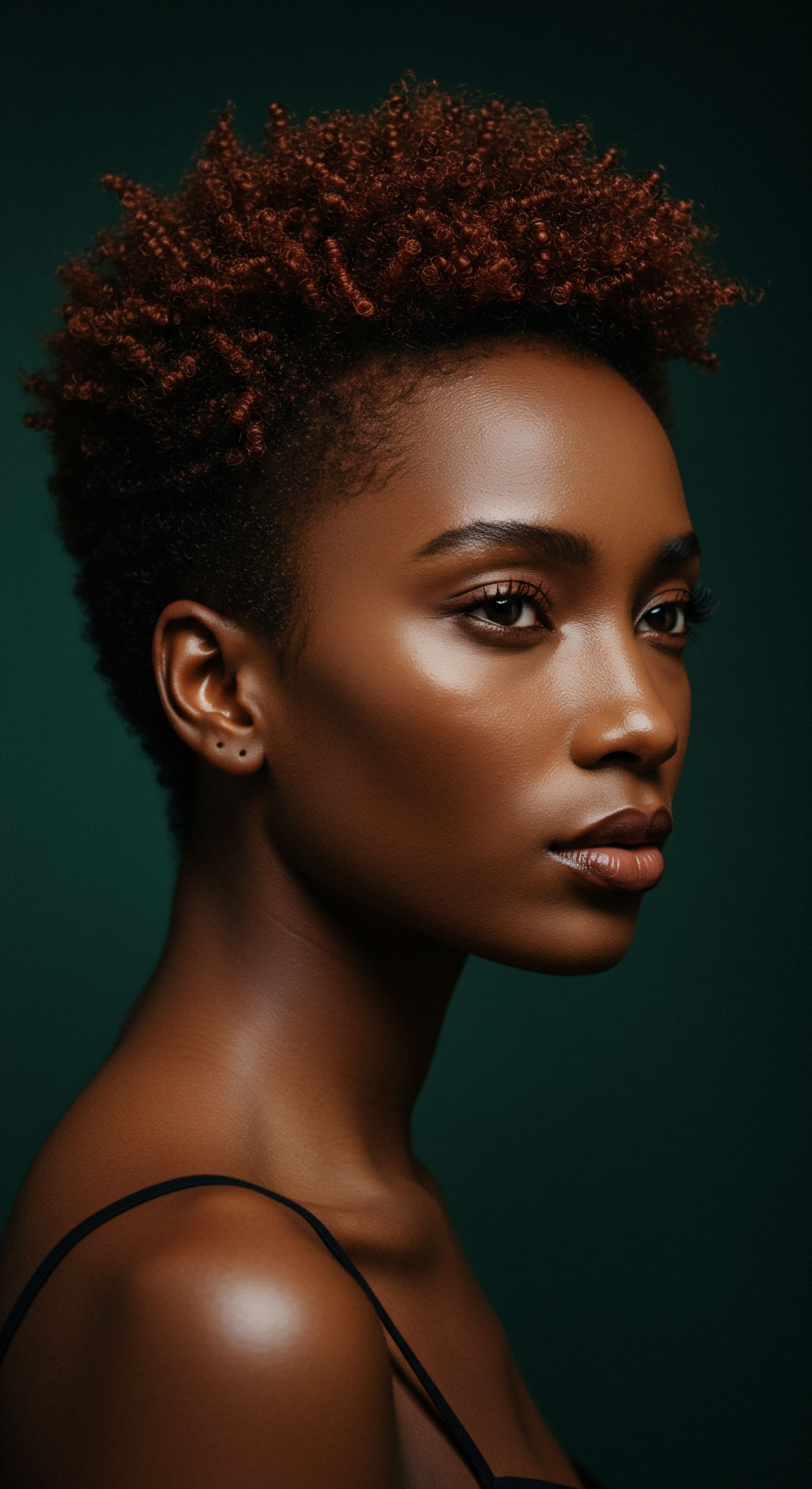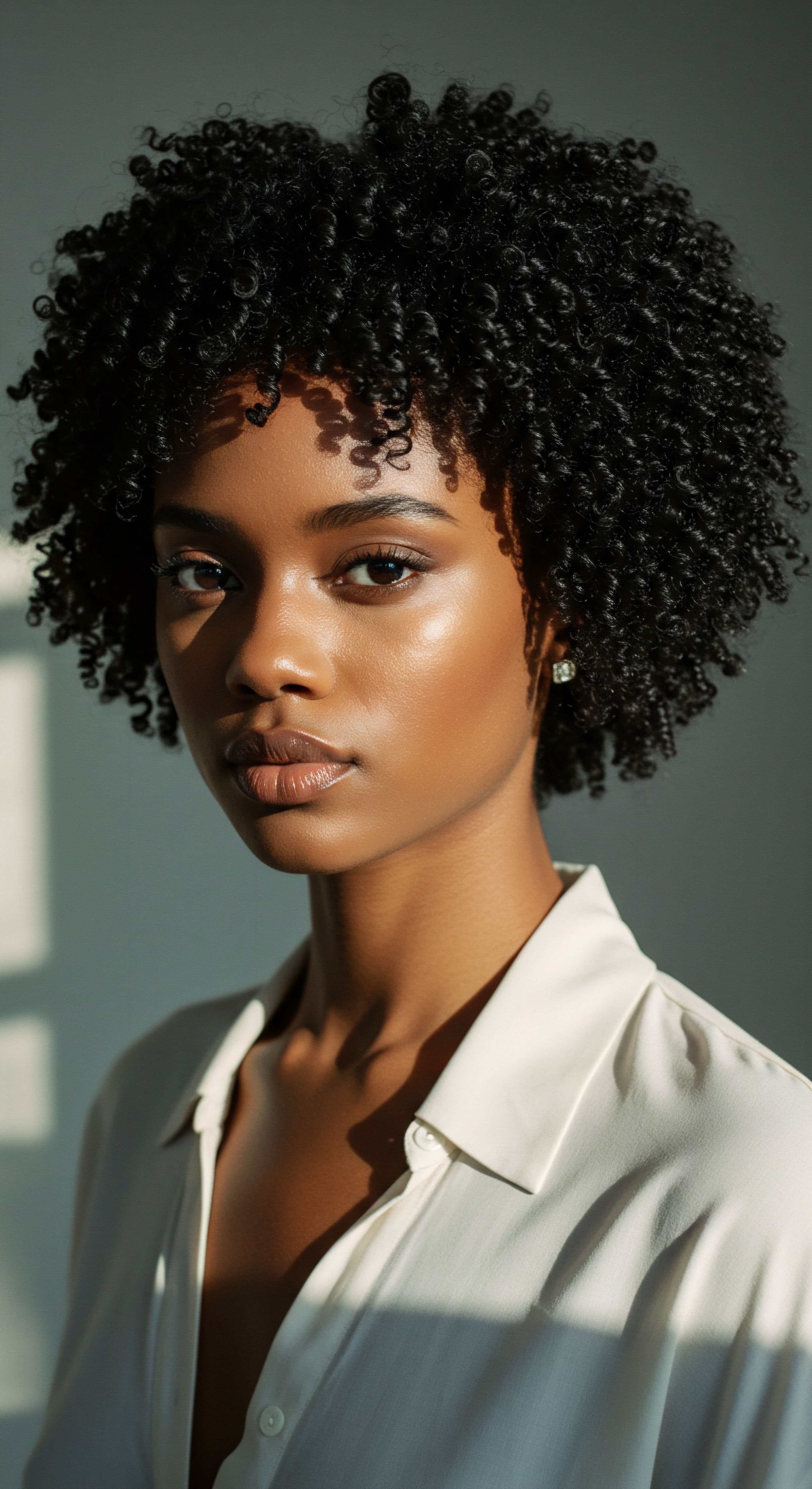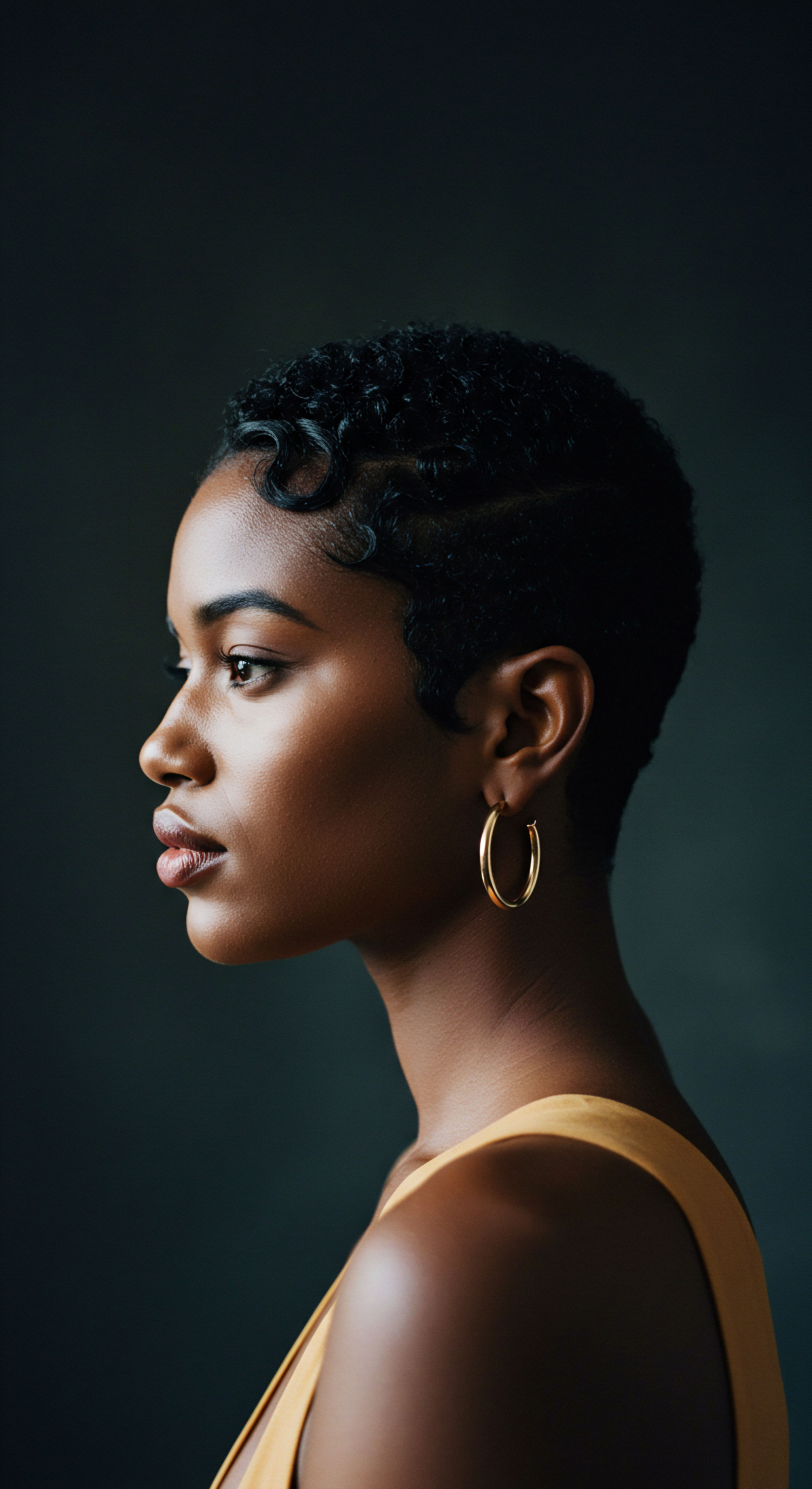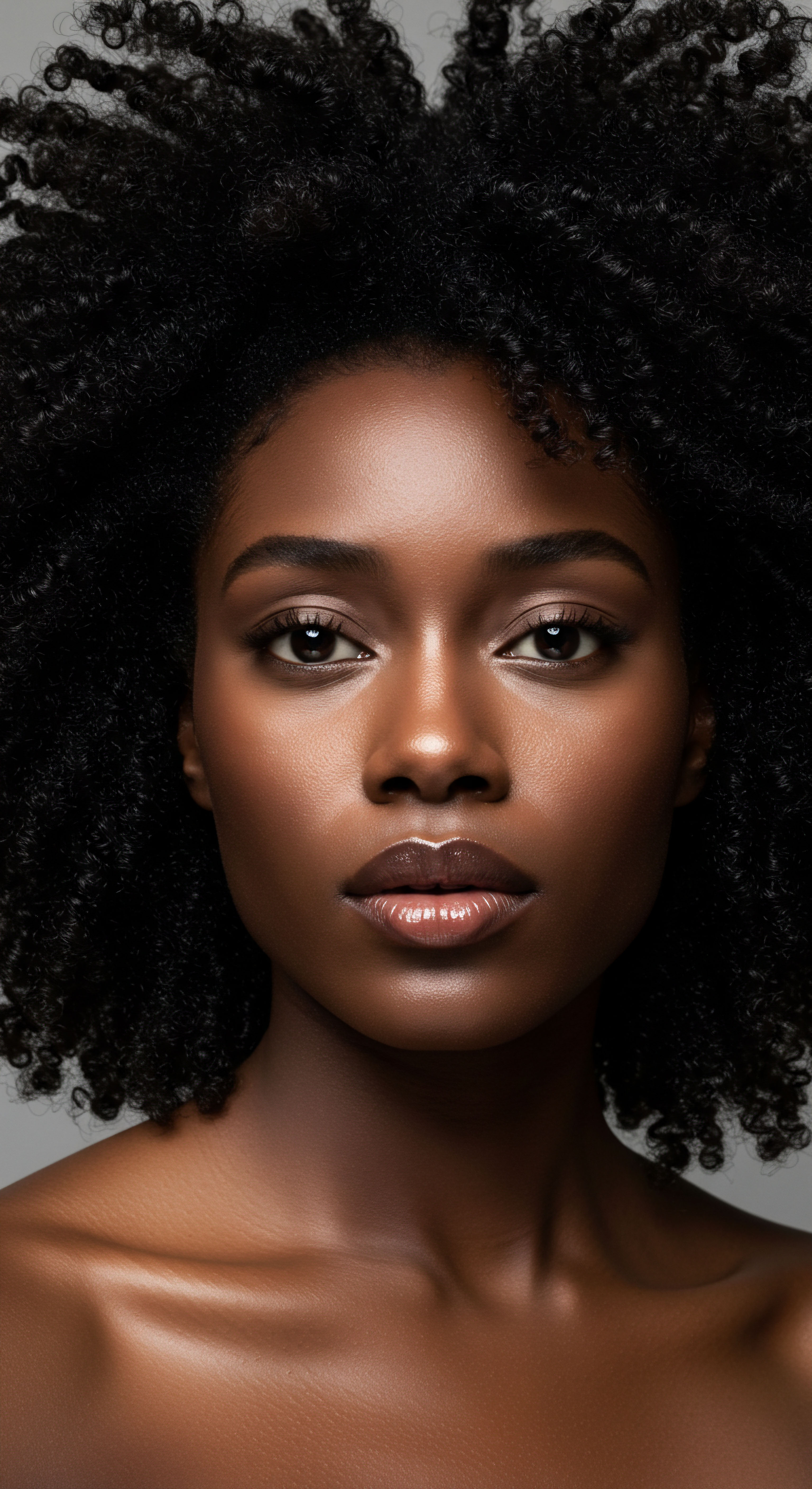
Roots
There exists a quiet knowing, a deep-seated intuition that whispers through generations about the care of our strands. For those with textured hair, this whisper often carries the weight of history, echoing practices passed down from grandmothers and aunties, traditions born of necessity and deep understanding. Can the gentle wisdom of ancestral nighttime hair care truly stand alongside the precise, often clinical gaze of modern science?
This question invites us to look beyond the superficial, to seek common ground where tradition and empirical data might meet, revealing a richer, more complete picture of hair wellness. It is a journey not of discarding the old for the new, but of illuminating the enduring efficacy of practices that have graced countless heads through time.
The very architecture of textured hair, with its unique coil and curl patterns, presents distinct considerations. Unlike straight hair, the natural oils, known as sebum, produced by the scalp find it challenging to descend the winding path of a coily strand. This inherent characteristic often renders textured hair more prone to dryness and, consequently, more susceptible to damage from external forces. This fundamental difference shapes the ancestral approaches to hair care, particularly those observed during periods of rest.

Understanding Hair’s Delicate Structure
At its core, hair is a protein filament, primarily composed of keratin. This protein forms the hair shaft, which is shielded by an outermost layer of overlapping scales called the Cuticle. The cuticle serves as a protective shield for the inner layers of the hair, including the cortex and medulla. The condition of these cuticle scales directly influences hair’s appearance, its smoothness, and its ability to reflect light.
When these scales lie flat, hair appears shinier and retains moisture more effectively. Conversely, when cuticles are raised or damaged, hair can become prone to frizz, split ends, and breakage.
Textured hair, by its very nature, often presents with cuticle layers that are not as tightly sealed as those found in straighter hair types. This structural variance means textured hair may absorb moisture quickly, yet also lose it with similar speed, making hydration a constant pursuit. The challenge, then, lies in preserving this delicate balance, especially during hours of unconscious movement.
Ancestral nighttime hair care, often born of necessity and observation, finds compelling resonance with modern scientific understanding of hair’s vulnerability during sleep.

The Night’s Hidden Harms to Hair
Our nightly slumber, a period of restoration for the body, can paradoxically become a time of silent assault on our hair. The constant tossing and turning against conventional pillowcases generate mechanical friction. This friction, often underestimated, causes damage to the hair cuticle, leading to a cascade of undesirable outcomes ❉ breakage, split ends, and frizz. For individuals with textured hair, already predisposed to dryness and cuticle fragility, this nightly interaction with rough fabrics like cotton can be particularly detrimental.
- Friction ❉ The rubbing of hair against surfaces, particularly rough fabrics, can lift and damage the hair’s protective cuticle layer, leading to frizz and breakage.
- Moisture Loss ❉ Absorbent materials, such as cotton pillowcases, can draw essential moisture from hair, leaving it dry, brittle, and susceptible to damage.
- Tangles and Knots ❉ Hair movement during sleep, exacerbated by friction, can cause strands to intertwine, forming knots that are difficult to detangle and increase breakage risk.
Consider the cumulative effect of these nightly aggressors. Over months and years, repeated damage to the cuticle can lead to chronic dryness, persistent frizz, and a noticeable lack of vibrancy. The very movements we make during sleep, estimated at an average of 40 head movements per night, translate into a staggering number of friction events over time, subtly eroding hair integrity. This background understanding of hair’s anatomy and its nightly vulnerabilities lays the groundwork for appreciating the wisdom embedded in ancestral care practices.

Ritual
Stepping into the realm of ancestral practices reveals a profound appreciation for hair as more than mere adornment; it is a living extension of self, a repository of cultural meaning, and a conduit for spiritual connection. The wisdom passed through generations often manifested as nighttime rituals, designed to safeguard hair from the day’s wear and the night’s subtle aggressions. These practices, once viewed through a purely cultural lens, now invite a closer look through the microscope of modern science, asking if their efficacy can be quantitatively affirmed.
The practice of wrapping hair before sleep, for instance, spans continents and centuries, deeply embedded in diverse cultures, from African traditions to Jewish and Muslim customs. Historically, headwraps served a multitude of purposes ❉ protection from the elements, cultural identity, and even social status. For enslaved African women, headwraps became a means of protecting hair from sun, sweat, and lice during arduous labor, and later, a symbol of resilience against oppressive laws. The persistence of these practices suggests an inherent understanding of hair’s needs, long before scientific laboratories could dissect its structure.

Can Fabric Choice Change Hair Health?
A central tenet of ancestral nighttime hair care, particularly within textured hair communities, involves the deliberate choice of sleep coverings. The modern resurgence of Silk and Satin Bonnets and pillowcases is not simply a trend; it echoes an ancient understanding of material properties. Scientific inquiry now lends considerable weight to this inherited wisdom.
Unlike coarse fabrics such as cotton, which possess a higher friction coefficient, silk and satin offer a remarkably smooth surface. This smoothness significantly reduces the friction between hair strands and the sleeping surface. When hair glides rather than snags, the delicate cuticle layers remain undisturbed, preventing the lifting and damage that lead to frizz, split ends, and breakage.
The shift from traditional cotton to silk or satin for nighttime hair protection offers measurable improvements in hair health by minimizing friction and preserving moisture.
A study focusing on silk bonnets, for instance, found a substantial reduction in hair breakage. Research confirms silk bonnets reduce breakage by up to 43% compared to cotton alternatives over an eight-week period. This tangible data point provides a compelling scientific validation for a practice long held sacred in many cultures.
Furthermore, cotton’s absorbent nature means it can draw moisture from hair, contributing to dryness. Silk, conversely, absorbs considerably less moisture—around 11% of its weight, compared to cotton’s 25%. This difference helps hair retain its natural hydration throughout the night, a critical factor for textured hair which is already prone to dryness.
| Material Cotton |
| Friction Level High |
| Moisture Absorption High (absorbs up to 25% of weight) |
| Impact on Hair Cuticle Lifts and damages, causes frizz and breakage |
| Material Silk |
| Friction Level Low |
| Moisture Absorption Low (absorbs only 11% of weight) |
| Impact on Hair Cuticle Maintains integrity, reduces frizz and breakage |
| Material Satin (synthetic) |
| Friction Level Low |
| Moisture Absorption Variable (can be less breathable) |
| Impact on Hair Cuticle Reduces friction, prevents damage |
| Material Choosing low-friction, less absorbent materials significantly benefits hair health during sleep. |

How Do Protective Styles Help?
Beyond material choice, ancestral practices often involved specific styling techniques for nighttime. Loose braids, twists, or simply gathering hair atop the head in a “pineapple” style are not merely aesthetic choices; they serve a practical purpose. These protective styles minimize hair movement, thereby reducing tangles and friction against the pillow.
For long hair, braiding can prevent crushing and knotting that occurs with unrestrained movement. A loose braid, secured with a gentle scrunchie rather than a tight elastic, protects the hair shaft from tension and breakage. This simple act, often performed instinctively by generations past, finds its validation in studies showing that tight hairstyles can cause tension and pull at the hair root, potentially leading to damage and even traction alopecia in extreme cases.
The deliberate act of preparing hair for rest, whether through specific wraps or gentle styling, demonstrates a continuity of care that transcends mere cosmetic concern. It is a testament to the power of observation and adaptation, yielding practices that science now meticulously quantifies and endorses.

Relay
The conversation surrounding ancestral nighttime hair care deepens when we consider the subtle yet profound interplay of environmental factors, product application, and the very biological rhythms of our bodies. How do the enduring traditions of nighttime hair oiling or scalp care stand up to contemporary biochemical scrutiny? This section invites a more precise lens, examining the molecular and physiological underpinnings that lend scientific credibility to practices passed down through time.

Can Nighttime Oiling Offer Unique Benefits?
Hair oiling, a practice deeply rooted in many cultures, particularly in South Asia and Africa, often includes overnight application. This tradition suggests a belief in prolonged contact for deeper nourishment. Modern science offers insights into why this might be beneficial.
Hair oils, such as coconut, almond, or argan oil, are rich in vitamins, fatty acids, and antioxidants. When applied to the hair and scalp, these oils can penetrate the hair shaft, forming a protective barrier that helps lock in moisture and guard against damage. This is particularly significant for textured hair, which, as discussed, is more prone to dryness due to the difficulty of natural sebum distribution.
A study from 1999, focusing on coconut oil, highlighted its capacity to reduce the tendency of the hair cuticle to swell, thereby minimizing protein loss during washing and combing. This suggests that a pre-wash oil treatment, often left on overnight, can fortify the hair’s structure against subsequent mechanical stresses. Regular overnight oiling has been linked to several benefits:
- Deep Nourishment ❉ Prolonged exposure allows oils to provide comprehensive nourishment to the scalp and strands.
- Hair Fortification ❉ Consistent overnight oiling can reduce protein loss, contributing to stronger hair from within.
- Scalp Hydration ❉ Individuals with dry scalps may find relief from flakiness and itchiness through extended oil exposure.
- Frizz Management ❉ Oils smooth the hair cuticle, reducing frizz and enhancing manageability.
However, the science also introduces a nuanced perspective. While traditional practice often advocates for overnight oiling, some modern dermatologists suggest that a maximum of 60 minutes might suffice for absorption, particularly if using harsh shampoos afterwards that could strip natural oils. This highlights a point of refinement ❉ the benefit of oiling is not simply duration, but also the subsequent care routine. If leaving oil on overnight, selecting a breathable head covering like a silk bonnet is advisable to prevent dust accumulation and protect bedding.

Does Nighttime Hair Wrapping Affect Scalp Physiology?
Beyond protecting the hair shaft, the act of covering hair at night, particularly with breathable fabrics, can influence the scalp environment. While concerns about trapping heat or moisture with non-breathable materials exist, leading to potential irritation or fungal issues, breathable fabrics like silk or satin mitigate these risks.
The reduction in friction provided by these materials extends to the scalp as well. Constant pressure and rubbing against a rough pillowcase can affect blood flow to the scalp and potentially stress hair follicles. While sleeping on one side is unlikely to directly cause hair loss, prolonged pressure can contribute to breakage or even traction alopecia over time. By creating a smoother interface, bonnets and silk pillowcases lessen this mechanical stress, supporting healthier follicle function and potentially reducing tension-related damage.
The scalp’s microbiome, a delicate balance of microorganisms, thrives in a stable environment. While direct research on how specific nighttime coverings impact this balance is still evolving, the principle of minimizing irritation and maintaining appropriate moisture levels aligns with overall scalp health. A well-maintained scalp provides the optimal foundation for hair growth.

The Scientific Validation of “Why”
The enduring legacy of ancestral nighttime hair care techniques finds its scientific validation not in a single grand discovery, but in the confluence of numerous small, yet significant, physiological and material interactions. The deliberate actions of wrapping, braiding, and oiling hair before sleep are not merely cultural relics; they are sophisticated strategies for mitigating damage, preserving moisture, and maintaining hair integrity at a microscopic level.
The understanding that textured hair is inherently more prone to dryness and mechanical damage due to its unique morphology underscores the genius of these protective practices. The scientific community now provides quantifiable data on how silk reduces friction and retains moisture, effectively confirming what generations already knew through lived experience and careful observation. The global headwear market, including silk bonnets, is projected to grow significantly, reaching US$35.0 billion by 2032, a clear indicator of mainstream recognition for these protective solutions. This growth is directly tied to increasing consumer awareness of hair health and damage prevention, mirroring the benefits long championed by ancestral methods.
These practices, once perhaps seen as simple customs, are now recognized as astute applications of material science and hair biology. They offer a powerful illustration of how traditional wisdom, when viewed through a contemporary lens, can illuminate pathways to healthier, more resilient hair for all.

Reflection
As we draw this exploration to a close, the echoes of ancestral nighttime hair care techniques resonate with a newfound clarity, amplified by the affirming voice of scientific understanding. The journey has not been one of proving ancient wisdom right or wrong, but rather of recognizing the deep, intuitive grasp of hair biology that underpinned these practices. The gentle ritual of wrapping hair in a silk bonnet or braiding it loosely before sleep, once perhaps a quiet act of self-preservation or cultural adherence, now stands as a testament to intelligent care.
It speaks to the universal desire for well-being, translated through generations into tangible acts that science now dissects and applauds. The convergence of these two worlds — the whispers of our forebears and the precision of the laboratory — offers a profound appreciation for the enduring power of mindful self-care.

References
- Rush Hair & Beauty. How To Protect Your Hair While Sleeping.
- Terziler, Dr. Does Sleeping on Only One Side Cause Hair Loss?
- Strands of Silk. The rich history of silk and hair wrapping. (2020-09-25)
- Nourished Springs. How does friction affect Afro textured hair? (2024-08-30)
- The Wrap Life. A Beautiful Record of How Modern Headwraps. (2022-01-11)
- HairKnowHow.Com. High Porosity Hair ❉ What It Means For Your Hair.
- Drowsy Sleep Co. Sleep Masks and Hair Care ❉ Prevent Breakage and Frizz.
- HairKnowHow.Com. How to Care for High Porosity Hair ❉ 10 Expert Tips.
- The Silk Collection. How Silk Bonnets Transform Hair Health ❉ Expert Insights and Evidence. (2025-05-05)
- Slipssy. The Long-Term Effects of Slipssy ❉ Protecting Your Hair Follicles, Pres. (2025-04-16)
- Ari Party Hair. The History and Symbolism of Hair Wrapping Across the African Diaspora. (2025-02-18)
- JD Institute of Fashion Technology. HEADWRAPS ❉ HISTORY AND EVOLUTION. (2021-06-23)
- Clinikally. 10 Effective Ways to Protect Your Hair While You Sleep. (2023-07-25)
- BAD Patient Hub – Skin Health Info. Caring for Afro-textured hair.
- Pattern Beauty. High Porosity Hair Care 101 ❉ A Complete Guide For Natural Textures. (2025-01-11)
- Little Extra. How to Prevent Split Ends While Sleeping. (2023-01-25)
- AllThingsBeauty. How to Build a Regimen Based on Hair Porosity. (2023-07-30)
- The Natural Hair Advocate. Wrap it Up ❉ A Tribute to the Head Tie. (2016-05-31)
- Silkie. The Link Between Sleep Position and Hair Damage ❉ What You Need to Know.
- Kérastase. Hair Cuticle Care ❉ The Complete Guide to Protecting and Strengthening Your Hair. (2024-12-16)
- Esteworld. Does Sleeping on Only One Side Cause Hair Loss?
- Natural Products. Modulation of Hair Growth Promoting Effect by Natural Products.
- Healthshots. 8 tips to prevent hair loss while sleeping. (2024-09-27)
- MDPI. Natural alternatives from your garden for hair care ❉ Revisiting the benefits of tropical herbs.
- Healthline. How to Sleep with Long Hair to Protect the Health of Your Hair. (2021-09-06)
- Sew Historically. Night-Time Hair Routine – Victorian And Edwardian Hair Care. (2015-07-27)
- Hindustan Times. Is overnight hair oiling right for you? Know what experts say. (2025-02-25)
- Strand & Lock. 8 Ways to Protects Hair While Sleeping. (2023-04-25)
- Reddit. What’s your country/culture feature when it comes to hair care? (2020-06-07)
- Deerfield Academy. Black and Beautiful ❉ Satin Bonnets for Hair Repair. (2022-07-12)
- Olaplex. What Causes Hair Damage? (2024-08-19)
- Cosmetics & Toiletries. Defying Damage ❉ Understanding Breakage in Afro-textured Hair. (2020-01-30)
- I Love Riccio. How not to damage curly hair at night.
- Alibaba.com Reads. Silk Bonnets ❉ The Rising Star in Hair Care Accessories. (2024-12-25)
- ROYSBERG. The Best Hair Accessories for Protecting Your Hair While You Sleep. (2024-10-17)
- Prose. The Cut Down ❉ 3 Types of Damaged Hair and How to Repair Each. (2021-06-10)
- Reddit. The Indian hair oiling tradition is bad? ❉ r/india. (2023-08-19)
- MDPI. Exploring the Use of Natural Ingredients for the Protection of Textured Hair from Ultraviolet Radiation ❉ An In Vitro Study.
- The Earth Collective. Morning vs. Evening Indian Hair Care Routine ❉ Which Is Best? (2024-07-08)
- Mayvenn. Does Wearing a Bonnet Cause Hair Loss? Protective Styling and Hair Health. (2025-04-15)
- The Silk Collection. Silk Bonnet vs. Satin Bonnet | Why Use Real Silk Bonnets | Silk Hair Bonnet.
- Reddit. How do you sleep while protecting your fine waves (2a)? ❉ r/finehair. (2024-10-26)
- Glamour Garden. Traditional Indigenous Haircare ❉ Ancient Wisdom for Modern Hair Concerns. (2023-12-11)
- Oserth. Embracing Cultural Practices for Healthier Hair. (2024-10-28)
- News-Medical.net. The Science Behind Healthy Hair. (2022-06-23)
- Rele, J. S. & Mohile, R. B. (1999). Effect of mineral oil, sunflower oil, and coconut oil on prevention of hair damage. Journal of Cosmetic Science, 50(1), 51-62.
- UVA ChemSciComm. Chemistry of Wellness ❉ Hair and Hair Care.
- ResearchGate. Enhancing Hair Health. Effects of Oiling, Inside & Out, Part I.
- Iris Garden. Hair Oil Before Bathing – A Timeless Tradition or an Overhyped Myth? (2024-10-30)